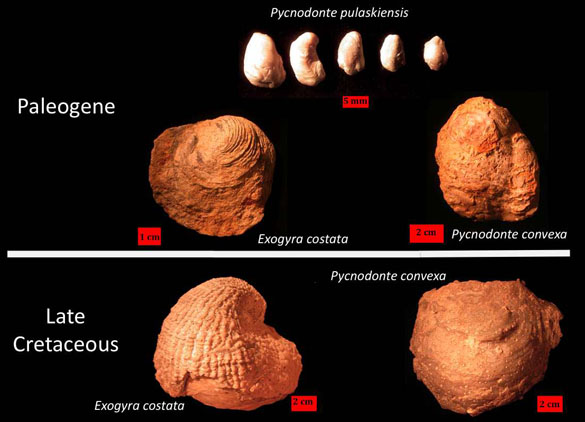
This is my research team at a road-cut locality in Mississippi. (Photo courtesy of George Phillips.)
Editor’s note: Senior Independent Study (I.S.) is a year-long program at The College of Wooster in which each student completes a research project and thesis with a faculty mentor. We particularly enjoy I.S. in the Geology Department because there are so many cool things to do for both the faculty advisor and the student. We are now posting abstracts of each study as they become available. The following was written by Megan Innis, a senior geology major from Whitmore Lake, Michigan. You can see earlier blog posts from Megan’s field work by clicking the Alabama and Mississippi tags to the right.
During the summer of 2010, I traveled to Alabama and Mississippi with my research team including Dr. Mark Wilson, Dr. Paul Taylor, and Caroline Sogot. Our trip was about ten days and included fieldwork and research. The purpose of our research was to collect fossils from below and above the Cretaceous-Paleogene (K/Pg) boundary to try and understand the Cretaceous mass extinction from a microfaunal level.
I chose to focus my thesis on oysters and the sclerobionts associated with these calcareous hard substrates. Although my study was focused on oysters, I also collected a wide variety of other specimens including nautiloids, ammonites, belemnites, corals, sharks teeth, and bryozoans.
When I got back to school in August, I identified all of my oyster species (three total) and began to identify and collect data for the sclerobionts. The oysters from the Cretaceous included Exogyra costata and Pycnodonte convexa and the oysters from the Paleogene included Exogyra costata, Pycnodonte convexa, and Pycnodonte pulaskiensis.
I identified nine sclerobionts including Entobia borings; Gastrochaenolites borings; Oichnus borings; Talpina borings; serpulids; encrusting oysters; encrusting foraminiferans; Stomatopora bryozoans; and “Berenicia” bryozoans. My research showed:
1) Bioerosion of oyster hard substrates was common in the Late Cretaceous and Paleogene and sclerobionts were abundant before and after the extinction.
2) Entobia sponge borings appear to increase in abundance across the K/Pg boundary and become more common in the Paleogene.
3) Gastrochaenolites borings, made by bivalves, and serpulids were more prevalent in the Late Cretaceous, suggesting boring bivalves and serpulids were significantly reduced after the extinction.
4) Encrusting oysters and foraminiferans were more common in the Late Cretaceous, but also relatively abundant on Pycnodonte pulaskiensis in the Paleogene.
5) Encrusting bryozoans were more common in the Late Cretaceous and absent in the Paleogene, suggesting bryozoans were severely affected by the extinction.
6) Talpina borings were only found on Pycnodonte pulaskiensis in the Paleogene, but no significant data was collected elsewhere.
To my knowledge, this is the first study of bioerosion on oysters across the K/Pg boundary.





Pingback: Wooster Geologists » Blog Archive » Wooster’s Fossils of the Week: Tiny little oysters (Lower Paleocene of Mississippi)